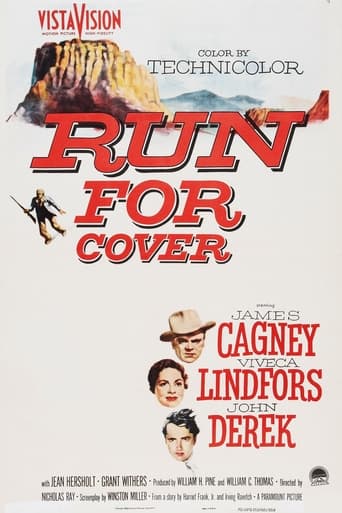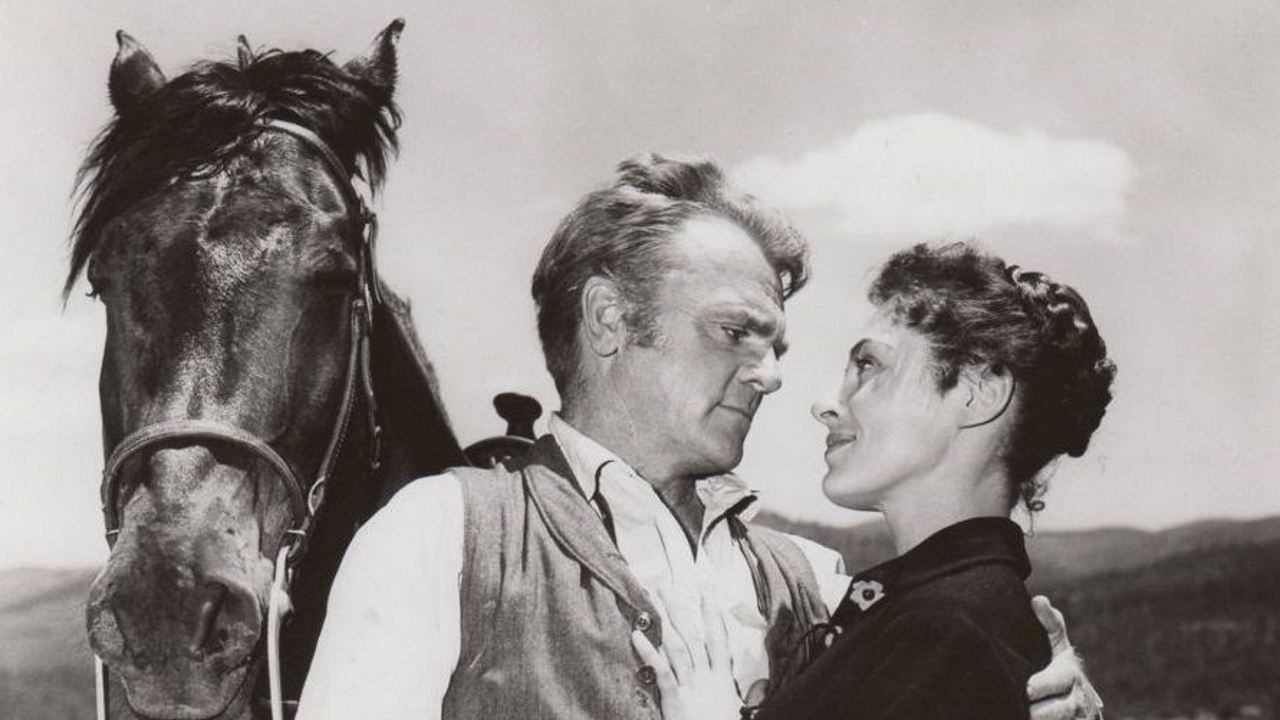Spikeopath
Run for Cover is directed by Nicholas Ray and adapted to screenplay by Winston Miller from a story by Harriet Frank Jr. and Irving Ravetch. It stars James Cagney, Viveca Lindfors, John Derek, Jean Hersholt, Grant Withers, Jack Lambert, Ray Teal and Ernest Borgnine. A Technicolor/VistaVison production, with music by Howard Jackson and cinematography by Daniel Fapp.When Matt Dow (Cagney) and Davey Bishop (Derek) meet up they quickly become friends, but events conspire to see them wrongly suspected of robbing the train heading for Madison. Hunted down by a Madison posse, Bishop, a Madison resident, is severely injured and Dow taken to town for possible lynching. What unfolds is the truth comes out and the two men end up working as the law in town, but there is many more secrets to be unearthed in this part of New Mexico...Nicholas Ray brings a meditative state to the picture, ensuring the thematics of surrogate families, generation conflicts, mob justice and the corruption of youth, are all delicately handled by the great director, even dealing in Freudian textures for the key character relationship. There's a whiff of High Noon in how Matt will inevitably have to stand alone, and he will also have to fight inner turmoil about injustices and cope with disappointments as things refuse to go to plan under Madison's glaring sun. But this is a skilled character piece able to stand on its own terms.As a looker the film is quite simply stunning. Filmed out of Durango, Silverton and Aztec (the latter providing the finale set in the Aztec Ruins), the scenery is breath taking, Ray and Fapp surrounding the story with an imposing beauty that is hard to take your eyes from. Cast are led superbly by a restrained and reflective Cagney, who can say so much with just one glance of his eyes, and while Lindfors as Cagney's love interest is a bit wooden, she's at least given some decent scripting to work with. Elsewhere nobody fails in bringing their respective characters to life.Absolutely lovely Oater, one that may not break new ground with its formula of plotting, but comes out roaring regardless. It makes you wish Cagney had made more Westerns, Nicholas Ray also, while Fapp's photography here is alone worthy enough to consider catching this on any potential Blu-ray release. 7.5/10
alexandre michel liberman (tmwest)
In April, 30, 1955 Bosley Crowther in the New York Times compared this film unfavorably with High Noon stating "there is little in "Run for Cover" to compare with the lean, leathery pictorial poetry and the stunning social comment of "High Noon." For this William Pine-William Thomas Western, directed by Nicholas Ray, is sheer horse opera without freshness or feeling and with practically nothing to say." I totally disagree with Crowther and his point of view is just a sample of how this western was unappreciated when originally released. If in High Noon there is a social comment, in "Run For Cover" there is a great psychological study of how individuals react when life gives them a hard time. Just the words Cagney beautifully says:" You think you got a raw deal? It comes with the ticket, nobody guarantees you a free ride, the only difference is most people don't run for cover, they keep right on going picking up the pieces the best way they can" are worth the film. This is a colorful, well directed western with good action scenes, entertaining from beginning to end. Don't miss it!!
classicsoncall
If you've seen Jimmy Cagney in a few of his famous gangster roles, his appearance in a Western might be enough to make you scratch your head. I had that reaction the first time, when I caught him as a 'good' bad guy in "The Oklahoma Kid", opposite another actor you might peg the same way - Humphrey Bogart. That picture was filmed in 1939 and you had a much younger Cagney riding hell bent for leather and engaging in a wild saloon brawl with his co-star. Even so, he was forty years old at the time, while here, he's in his mid fifties and a bit slower on the draw as his character Matt Dow emphasizes a number of times. Cagney appears a bit more comfortable in his role here than he did as 'The Kid', in fact I did a few double takes as he resembled an older Audie Murphy a few times.The story has a couple of interesting turns, starting right out of the gate when Matt Dow hooks up with local cowpoke Davey Bishop, and they unwittingly fall into possession of a train payroll when two employees who have been robbed before under similar circumstances figure it would be easier to just give it up. Bishop is portrayed by John Derek, who I've seen in a few Westerns as well, and he too looks like he'd be more comfortable in a different type of film, say as an angst ridden youth or a slick motorcycle gang member. Although I did like him in "Fury at Showdown", another Western with a great brawl, maybe the best I've ever seen, if not the longest.While Bishop recovers from severe wounds received by the posse that hunted them down for the lost payroll, Cagney's character sparks up a romantic interest with the woman who nurses Bishop back to health. At first I wasn't sure if Helga Swenson (Viveca Lindfors) was using Matt to get to know Bishop better; she appeared a lot closer in age to the younger sidekick. I guess it could have been written either way, but this was Cagney's picture. It was clever the way Cagney's character got old man Swenson (Jean Hersholt) to allow Matt to earn his keep while Davey recovered. The old guy was pretty sharp though, he knew what Matt was doing the entire chess game before the subject of matrimony came up.The story got interesting with the robbery at the church service, leading to another twist in the story regarding Bishop's character. With greed winning out over his conscience, Bishop turns on his mentor, only to reverse himself in the finale. In a somewhat unusual ending, Matt comes through for the town folk once again, but at a price. You can see it coming, but it could have gone a couple of different ways, with the outcome another twist to your typical bad guy learning from his mistakes scenario.Here's something interesting about the casting for the picture - in Cagney's very first film, he portrayed a young hood who worked for a mobster played by Grant Withers. In this one, Withers is the outlaw who robbed the church goers. Funny how things go sometimes. The picture also offers a brief appearance by Ernest Borgnine, also as a bad guy taken out by Matt.The film was directed by Nicholas Ray, which helps explain some of the focus on John Derek's troubled character. For an even better Ray/Derek collaboration, you'll have to check out 1949's "Knock On Any Door", with Humphrey Bogart in the lead role. Derek portrays a young man with a criminal past who reaches the end of the line when he winds up killing a cop. For his part, Nicholas Ray marked the epitome of his directorial achievement with his epic story of teenage angst - "Rebel Without A Cause".
Nazi_Fighter_David
Nicholas Ray will be remembered for "The Lusty Men," "Johnny Guitar," "Run for Cover," and "The True Story of Jesse James."With a slight echo of "High Noon," the film is Cagney's first Western, shot in stunning Technicolor and VistaVision, since Lloyd Bacon's "Oklahoma Kid" in 1939... Cagney was beginning to show his age, but his performance is colorful as always... It is interesting to remark that Grant Withers whom Cagney had supported in his film debut ("Sinner's Holiday," 1930) and his third movie ("Other Men's Women", 1931) is in his support as Gentry....Released from a six-year prison term for a crime he did not commit, Cagney goes West, where he meets John Derek...Riding along, they innocently become involved in a train robbery and are later ambushed by a posse... Derek's leg is smashed and is taken to Viveca Lindfors' farm where she nurses him and falls in love with Cagney...The townsfolk offer Cagney the tin star, and he appoints Derek (who is now a cripple), as his deputy...Derek's bitterness over his bad accident separates the two men in different directions and soon are seen on opposite side in a fight involving Grant Withers' widely known gang and a group of Indians...



 AD
AD


